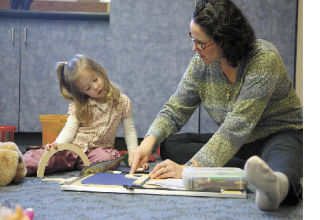The prevalence of autism, a neurobehavioral disorder of children characterized by delayed and atypical communication skills, atypical socialization skills and repetitive behavior patterns, has increased markedly in the past 20 years, to the point that it is estimated that as much as 1 in 150 children have a form of autism.
Almost everyone has a relative or knows of a family with an autistic child or adult member. In fact, it seems like every magazine, newspaper, and TV news program has reported on the “epidemic” of autism in the past few years.
Autism has become one of the hottest medical and educational research topics across the country, receiving $211 million for research in President Barack Obama’s proposed 2010 budget. And from 2005-08, Washington completed a statewide Autism Task Force, culminating in publishing the “Autism Guidebook for Washington State: A Resource for Individuals, Families, and Professionals,” available online at www.doh.wa.gov/cfh/mch/Autism/guidebook.htm. Also, a statewide interdisciplinary “Combating Autism Advisory Committee” was formed to oversee the implementation of cutting-edge diagnostic and treatment services for children and adults with autism.
When I started practice 30 years ago, autism wasn’t diagnosed as frequently. Currently, I estimate nearly half the children referred to me from other physicians are related to the possibility of autism.
Parents are often the first ones to suspect their child is developmentally delayed and might have autism. Access to information about autism warning signs, especially on the internet, is readily available.
Parents often suspect their child might be delayed in communication or early social skills as early as 12 to 18 months of age. With the use of early screening tools, the current goal is to identify children with autism before 24 months and immediately refer each child to appropriate intensive educational intervention services.
Once a child is suspected of having autism, his or her parents face a number of choices regarding diagnosis and intervention. Some of the most common concerns parents ask are listed below:
Q. How is autism diagnosed?
A. Autism is currently defined entirely by a child’s developmental and behavioral characteristics in communication, socialization and repetitive behaviors. A child is usually diagnosed following a sequential process of developmental screening and formal assessment by a physician and/or clinical psychologist.
Q. What causes autism?
A. At this time, the “cause” of autism is unknown. Current autism research is focusing on a combination of genetic predisposition and a wide range of potential environmental factors. Some potential “causes” of autism have very strong anecdotal support on the Internet, but most have not been subjected to rigorous scientific research. However, the link between childhood immunizations and autism has been repeatedly studied and refuted by multiple scientific organizations. In fact, the American Academy of Pediatrics strongly encourages parents to continue to immunize their children.
Q. Does my child need a medical evaluation?
A. There are currently no specific medical tests for autism. There are selected medical tests recommended for some children with autism who also have significant developmental or intellectual impairments. Children with autism often have associated medical problems, particularly in the areas of intestinal function, nutrition, sleep, and/or severe disruptive behaviors, and may require referral to a medical specialist in these areas.
Q. Is there any effective treatment?
A. Autism outcome research has shown that children with autism can make substantial developmental and behavioral progress if they receive appropriate early intensive behavioral intervention services. These services need to be provided both at home and in other settings.
Parents require enormous support to implement the home portion of this intervention, optimally including the services of an autism behavioral specialist. However, health insurance companies often exclude payment for specific autism treatment, but a bill requiring medical coverage to all children with autism is currently pending in the Washington Legislature (Senate Bill 5203/House Bill 1210; “Shayan’s Law”). There are currently no specific medical treatments for autism, but some children benefit from occupational therapy, speech therapy and/or behavioral medications and/or medical treatment of associated medical problems.
Q. Where can I get more information on autism?
A. Currently, a wealth of accurate information on autism is available to parents, particularly on the Internet. There is equal availability of well-intentioned but unproven treatment options. I recommend the guidebook mentioned above and begin an Internet search with Web sites that maintain a high standard of up-to-date and peer-reviewed information; examples include:
• Autism Society of Washington, www.autismsocietyofwa.org
• Cure Autism Now, www.cureautismnow.org
• Autism Speaks, www.autismspeaks.org
• Washington Families for Effective Treatment of Autism, www.featwa.org
• Washington Autism Advocacy, www.washingtonautismadvocacy.org
Dr. Glenn Tripp is a developmental pediatric physician with Mary Bridge Children’s Hospital and Health Center. He is a graduate of the medical school at the University of Arkansas and Letterman Army Medical Center Pediatric Residency. He completed a fellowship at Madigan Army Medical Center and is board certified in pediatrics and developmental behavioral pediatrics.


